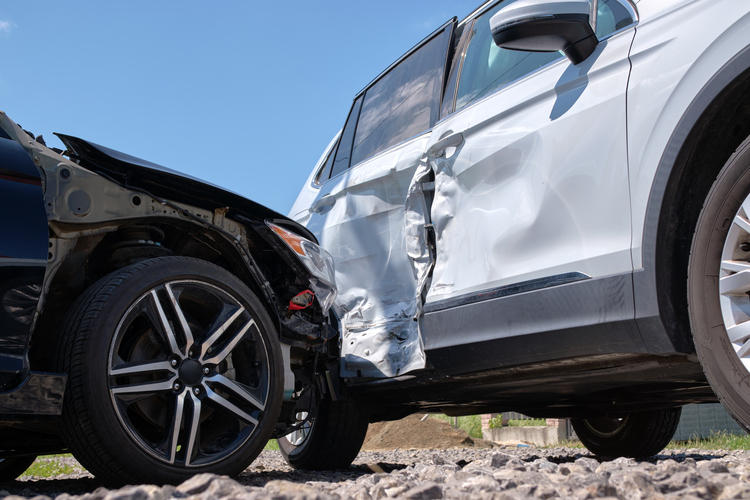T-bone car accidents are named for the shape that the vehicles make when they collide (a capital letter T). Side-impact and head-on crashes are both well-known for producing grave, sometimes fatal, injuries. Most T-bone accidents can be attributed to failure to yield, so determining fault is often fairly straightforward. However, some situations involve negligence on the part of both drivers and establishing liability can get murky.
An experienced Denver truck accident attorney can sift through conflicting testimony to determine the facts of the case and help you secure full and fair compensation for all your losses.
What is a T-bone car accident?
T-bone crashes happen when one driver fails to yield the right-of-way to another vehicle. Several common scenarios can result in a T-bone crash:
- Scenario 1: Driver A is turning left at an intersection with a blinking yellow arrow. Driver B, going straight from the opposite direction, strikes Driver A as they turn, hitting the side of their car head-on. Driver A would be responsible for the crash, failing to yield to oncoming traffic.
- Scenario 2: Driver A is turning left at a 4-way stop. Driver B runs the stop sign as they are turning. Driver B would be responsible for the crash, for running the stop sign.
- Scenario 3: Driver A has a solid green arrow and is turning left. Driver B tries to “beat” a yellow light and runs a red light, hitting Driver A as they turn. Driver B is responsible for the wreck.
- Scenario 4: Driver A is making a left-hand turn on a blinking green arrow. They see Driver B in the distance but judge that they have enough time to complete the turn before Driver B reaches the intersection. But Driver B is speeding and hits Driver A as they’re turning.
In the first three instances, liability is fairly clear. However, in the last situation, either driver may be at fault. If Driver A had waited until they had a solid green arrow, they wouldn’t have been in the intersection when Driver B blew through. However, if Driver B had been driving the speed limit, they wouldn’t have reached the intersection when Driver A was turning, and Driver A could have safely cleared their turn.
These aren’t the only ways this type of car accident can occur, but they show a common pattern and how challenges with liability can arise.
How to establish fault in a side impact collision
Figuring out who caused a T-bone car wreck usually rests on determining which driver failed to yield. Your personal injury lawyer may have a professional accident reconstructionist review the crash and physical damage from both vehicles to explain to a jury how the crash occurred. Analyzing the logs of each vehicle’s Event Data Recorder (standard on all vehicles sold in the U.S. since 2014) can clarify the situation further. The EDR tracks each vehicle’s movements, speed, and torque and can be used to prove that one driver was speeding or may have slammed on their brakes to try to avoid the other car.
Witness testimony, photos or a video of the crash, including dash cam footage, and your medical records are also important elements used to prove fault. While the police report of the wreck may not be admissible in court as evidence, the information contained in it, including the officer’s narrative detailing how the wreck happened and who was likely at fault, may be quite useful in settlement negotiations.
How a car accident attorney helps victims secure damages
You may need extensive medical treatment for injuries sustained in a T-bone collision, and there may be no guarantee that you’ll fully recover. Common T-bone accident injuries like moderate to severe brain trauma, spinal cord injuries, lacerations from broken glass, or multiple bone fractures may leave victims permanently scarred or disfigured.
You may be unable to work for weeks or may even be disabled to the point where you cannot sustain gainful employment. Medical bills from a serious T-bone crash can easily top six figures. If you weren’t responsible for the crash, then the at-fault driver is liable for your damages.
A Denver car accident attorney can establish liability in the crash and total your material damages for a fair settlement. These include all current and future medical needs, lost wages if you missed time at work, property damage (repairing your car and replacing any other property damaged in the wreck), and all other out-of-pocket expenses you incurred. You’re also eligible to claim non-economic damages, which include your pain and suffering, emotional trauma, and diminished quality of life.
Get help after a t-bone accident
If you’ve been injured in a T-bone accident, you could be entitled to significant compensation for your injuries, medical bills, and other losses. Don’t wait—contact Zara Injury Law today at (866) 823-8288 for a free consultation with our experienced car accident lawyers who will fight for your rights and help you get the settlement you deserve.
